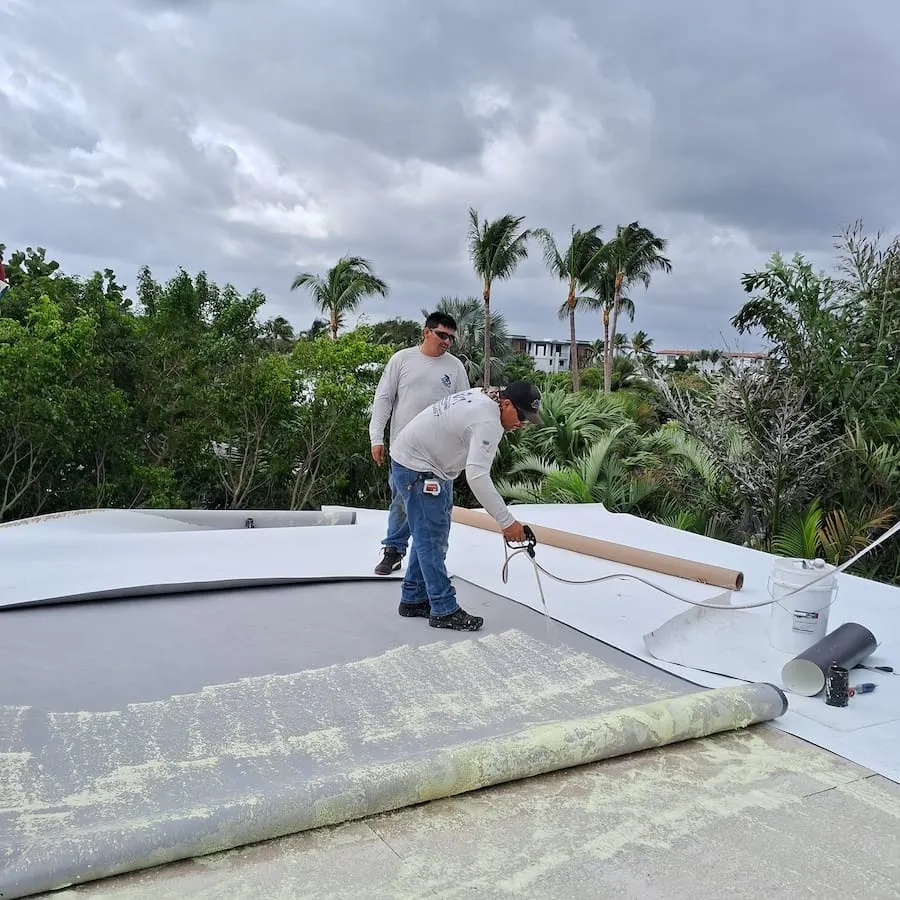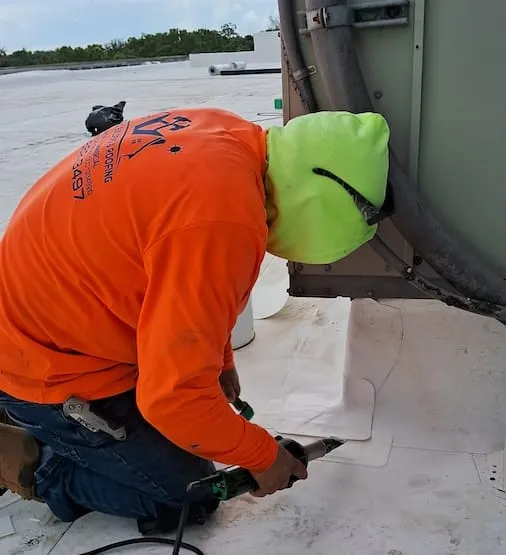Long Lasting Flat Roof Repair Solutions
Flat roofs are practical and widely used, but once leaks, standing water, or worn seams show up, the headaches begin. Many property owners patch the same spots over and over, only to see the problem come back the next season.
This guide cuts through the frustration by showing you which materials truly hold up, which repair solutinos add real years to your roof, and what maintenance steps protect your investment. Whether you’re a homeowner or managing a commercial property, you’ll find clear answers to make your flat roof repairs last.
Why Flat Roofs Need the Right Repair
Flat roofs show up on homes, businesses, and additions, but repairing them isn’t as simple as it looks. A lot of owners think, “I can walk on it, so it must be simple,” and grab something off the shelf at Home Depot. In reality, flat roofing is technical, and the wrong patch can make things worse.
You can’t patch a BUR roof with EPDM, and you can’t apply an elastomeric patch over a silicone coating. Standing water, UV exposure, and seam failures only add to the challenges. A sustainable leak repair comes from using compatible materials, proper installation techniques, and regular maintenance—not quick fixes that fail after a season. Learn more about the consequences of delayed flat roof repair
Understanding Flat Roof Materials
Flat roofing systems aren’t all the same. Here’s what’s out there and what you need to know about each.
TPO (Thermoplastic Polyolefin)
Popular for its welded seams, strong UV resistance, and warranties of 20–30 years. Available in different thicknesses, such as 45, 60, and 80 mil. Thicker membranes usually mean longer service life.
EPDM (Rubber)
Flexible and affordable. EPDM is known for strong weathering resistance, though seams are usually taped rather than welded.
Modified Bitumen
Asphalt-based with multiple plies for strength. It performs well in many climates but requires proper detailing.
Built-Up Roofing (BUR)
Traditional multi-layer system using bitumen and gravel. With enough plies, BUR can last decades.
Metal Systems
While not common on small homes, standing seam and coated metal can outperform most membranes.
Roof Sealant
Not a full system but sometimes used as a protective layer. Works only when matched with compatible roof materials and best for short-term waterproofing.
Thicker, reinforced membranes consistently last longer and come with stronger warranties, making them a smarter long-term investment.

Common Flat Roof Problems and Why They Fail
Flat roofs tend to fail at predictable points. Understanding these issues helps you spot trouble early.
Seam Separation: If seams aren’t welded or sealed correctly, water seeps underneath.
- Ponding Water: Poor drainage allows water to sit, breaking down membranes over time.
- UV and Heat Damage: Sun exposure dries out and cracks weak materials.
- Flashing Failures: Edges, walls, and penetrations like pipes often fail first.
- Cheap Repairs: Quick patches that use incompatible materials rarely last beyond one season.
It’s not enough to slap on a patch where you see water coming through, you need to understand the source of the problem. A crack or blister on the surface may look like the culprit, but leaks often start elsewhere. Water can enter at a poorly sealed penetration or edge detail, then travel under the membrane before finally showing up inside. Without tracking the leak back to its origin, any repair is just a temporary bandage.

Long-Lasting Repair Solutions
A strong repair does more than stop leaks. It extends the roof’s service life.
Seam Repairs
When a seam begins to fail, the repair must be made with the same type of material. If the roof is older, the original system may no longer be manufactured, which makes compatibility even more important. The loose section should be cut away and replaced with a new patch that covers the entire affected area. The patch should extend beyond the repair and overlap according to manufacturer specifications, usually between 3 and 6 inches.
Patching and Reinforcement
If you have an area that is punctured, sagging, or requires replacement of a full section, start by addressing what is beneath the membrane. Damaged wood decking or tapered insulation must be repaired or replaced before the patch is installed. Maintaining the proper slope is critical to ensure water drains correctly and does not pond after the roof repair.
Membrane Coatings
A flat roof membrane coating can be silicone, acrylic, polyurethane, or another system designed for protection. These products are not interchangeable, so if your flat roof already has a coating, you must reapply the same type or remove the old one before installing a new system. A common mistake is assuming that a coating alone will stop leaks. In reality, most leaks come from seams, penetrations, or flashing. Those areas must be repaired first to ensure the coating provides long-term protection.
Drainage Improvements
If your flat roof has drainage issues, the solution may be as simple as clearing debris from the existing drains or adding an additional drain to handle heavy water flow. The bigger challenge comes when the entire flat roof is not sloped correctly, causing water to pond instead of draining away. In those cases, repairs may require replacing sections of the roof or installing crickets to redirect water toward drains.
Flashing Upgrades
Flashing refers to the portions of roofing material designed to protect transitions on the roof. For example, when the membrane runs up a parapet wall, a termination bar is required to hold it in place and seal the edge. Flashing is one of the most technical parts of a flat roof system and must be installed according to strict specifications. Some materials, such as TPO, often come with pre-formed flashing components for pipes, corners, and edges, while others require custom fabrication on site. Getting these details right is critical because flashing failures are one of the most common sources of leaks.

How Flat Roof Repairs Are Done
A flat roof repair needs to follow a structured process to ensure it last:
- Inspection and Leak Tracing: A thorough check identifies the true source of water entry, not just the visible stain. The leak must be traced back to its origin, since a flat roof leak can travel up to 10 feet from the entry point and even move between layers of material.
- Surface Cleaning and Preparation – Dirt, debris, and damaged material are removed to give the patch or coating a solid bond.
- Seam and Flashing Repairs – Weak seams and flashing details are cut back and replaced with compatible materials.
- Patching or Coating – Reinforced membrane patches or protective coatings are applied, overlapping in line with manufacturer specifications.
- Final Inspection – Every roof repair is checked for proper welds, adhesion, and drainage to confirm long-term performance.
This process ensures repairs are done correctly the first time, saving property owners from repeated issues.
Warning Signs Your Flat Roof Needs Replacing
Even the best flat roof won’t last forever. Here are some clear signs it may be time to consider replacement instead of another repair:
- Frequent leaks that return even after patching
- Standing water that doesn’t drain after 48 hours
- Membrane cracks, blisters, or splitting seams
- Flashing that continues to separate or pull away
- Rising energy bills due to lost insulation value
- A roof that is more than 20 years old
If you’re noticing more than one of these issues, repairs may only delay the inevitable. A professional inspection will help you decide if a full replacement is the better long-term solution.
Frequently Asked Questions About Flat Roof Repair
What is the longest lasting roofing material for a flat roof?
Metal roofing and high-quality TPO or PVC membranes (80 mil) are the longest lasting. Properly installed, they can last 25–40 years.
How to permanently seal a flat roof?
Flat roofs can’t be sealed permanently, but the most reliable repair is to use the same type of material already on your flat roof. Mixing materials will not hold up. Always clean the surface thoroughly and follow the manufacturer’s installation instructions exactly.
What is the average cost to repair a flat roof?
Small repairs often cost $400–$1,200. Larger sections or coatings may run $2,000–$8,000. Full replacements start around $8,000 and can exceed $20,000 for large buildings.
Why Choose All Pro Builders & Roofing for Your Flat Roof Repairs
At All Pro Builders & Roofing, we bring more than 20 years of hands-on experience to every flat roof project. Our team is fully licensed, insured, and certified with leading manufacturers, which means we follow proven repair methods and back our work with strong warranties. We handle both residential and commercial Palm Beach roofing services, from small leak repairs on homes to full membrane replacements on large buildings. When you choose us, you’re getting more than just a quick fix—you’re getting expertise, trustworthy workmanship, and a flat roof that will protect your property for years.
Schedule Your Flat Roof Repair Now
A minor flat roof issue can quickly lead to serious water damage. At All Pro Builders & Roofing, we specialize in repairing flashing the right way, keeping your property safe and secure with prompt, professional service.
Sales@AllProBuildersRoofing.com
(561) 662-3497
Licensed & Insured | Florida License #: CCC1335472 | Over 20 Years of Roofing Experience
